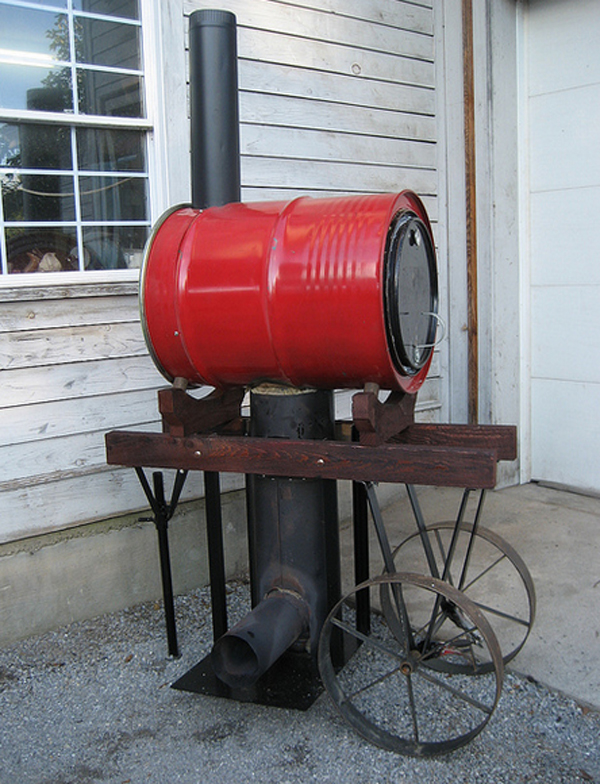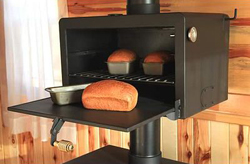
“If you want Great Pizza . . .You need an oven that gets HOT! This is rocket stove technology at it’s best! It only takes a small amount of wood and just over ten minutes, to push the temperature over 600 degrees.”
See more at the source: Flickr
Other alternative wood ovens:
Baker’s Salute Oven

Power outages or living off the grid won’t interfere with baking fresh bread, delicious cookies or a hearty roast. Unique, steel convection oven attaches to 6 inch pipe on wood or coal burning stove – mounts above saving floor space. Heats from stove’s exhaust which is contained in an air-tight jacket, then exits through your chimney.
Lehman’s.com
Grover Chimney Oven – Used on a Tent Stove or Wood Stove with 4” Flu
The Grover Chimney Oven is our latest product which will work great for all your baking outdoors using a 4″ flu on a small tent stove. Currently there isn’t any 4″ chimney ovens on the market that you can bake with without having to put on an adaptor for the 6″ and 5″ stovepipe stoves. These ovens will work great with our Wood Tent Stove that we sell or any wood tent stove that has a 4″ chimney flu.”
Source: Ebay
Free plans at Aprovecho Research Center

What do you think of using a clay slip perlite mix to form a domed oven, rocket burn chamber, and heat riser? I’m ready to build forms and get muddy, but not tooled up for metal work. The design is for the heat riser to vent near the ceiling at the back of the dome. I’ll form a tight door from the same material, and vent out through the oven’s the back near the floor. I hope to limit the wood burned and particulates produced while reducing our use of natural gas. I found one of your articles suggesting a high proportion of perlite to limit thermal mass in rocket stoves built from formed bricks. Does 3″ of 1 part clay slip to 14 parts perlite have similar performance to the metal stove in terms of time to heat up and temperature attained? Will it be structurally sound? Would I need to compress it to make it so? Will 6″ burn tunnel and ventilation diameters be adequate for an oven? Also, I’m considering the use of a wallboard texture sprayer to apply clay slip and perlite to form a dome oven. Mostly I see people using dry mixes including furnace cement, then packing it into forms, but they also form the dome by hand. If packing compresses air space while increasing adhesion, I’m wondering whether spraying this mix (without cement) onto a therapy ball and form is adequate. I may have to experiment with the ratio of slip to perlite to work in the sprayer. I could add layers of slip to form a half inch of solid clay on the outside reinforcing the insulating layers, but want to avoid too much in the insulating layers themselves. I’m thinking of doing the same to the floor inside of the oven even though it adds mass, forming a cooking surface. Any critical thoughts that help avoid failure are welcome.
There are many types of clay and the properties vary (stickiness, sand content, expansion, etc.). You’ll have to experiment. Start with a small test and work your way up.
Hi,
Just found your post on Low Mass Wood Fired Pizza Oven and am wondering if you have plans posted somewhere?
Thanks!
Contact the manufacturer.
Up-Dates to LICKER-TEE-SPLIT Low Mass Wood Fired Oven.
I’ve made some improvements to the fire chamber. It is now constructed using fire brick, backed up by an insulated refractory.
This slowed the initial fire-up of the oven, but improved the ability to sustain a more stable temperature.
The opening to the fire chamber is more convenient too. With the added mass it has good balance.
Listening to the fire burn, proves it is a “Rocker Stove” to the core. Soon after adding a piece of wood there are blue flames being emitted . . .little or No visible smoke.
Hi .. i see you have a great post ! i hope you could make another one like this .. keep posting then How to build a pizza oven .
I’ve fired my Wood Fired Low Mass Pizza Oven over ten times and the fire chamber is almost burned up. It’s time for materials that can withstand temps. in excess of 2200 deg.
The 2nd firing was completed with a convection fan installed. WOW … was my first response!
From the strike of the match & 15 minutes later 700 deg. was reached, 15 addition minutes and SIX pizza are baked.
That’s a total of 30 minutes and 1/2 dozen Pizzas Baked !
My oven easily held at 750 to 800 degrees, convection and Low Mass Wood Fired Barrel Ovens are a Winning combination ! This Oven spit these pizza out in about 2
minutes!
I was firing it on my back porch, under-roof, with NO visible smoke. Just hard to believe without seeing for yourself. I will post photos/and/or video when time permits.
Would love to build low mass wood oven. Where can i find plans for it.
Regards
Greg
There is plenty of insulation around the vertical fire tube.The horizontal pipe is stove pipe, which is almost burned up after a limited number of firings.
My new fire chamber material arrived today, it can withstand 23oo degrees. The gases pass through a stepped chamber, that changes direction four times. This path the gasses pass through is one inch wide, forcing more heat into the oven chamber. My stack temperature is about 260 f.
I will soon show my latest up-grades, but for now . . .
http://www.flickr.com/photos/procomfort/sets/72157634639807783/
Nice stove. Thanks for the update.
This oven is based on the Aprovecho design. Dean Still was the lead designer/researcher.
http://www.youtube.com/watch?v=z-g3jwv3R8Q
I suggest that Licker T Split version is a less efficient design than the Aprovecho design due to the very limited insulation around the rocket stove riser tube.
The plans for this design are available in the Aprovecho book:
“Capturing Heat 2” It is available on the http://www.Aprovecho.org website
The design is also available for free download on their website.
This link should redirect to a downloadable PDF file, but I’m not certain I’m copy and pasting the link properly.
http://www.aprovecho.org/lab/rad/rl/stove-design/doc/117/raw
If you can’t click that link and get the PDF, go to the following web page:
http://www.aprovecho.org/lab/rad/rl/stove-design/category/1
On the above page Click the download link for
“Capturing Heat Two: Part 1-Pizza Oven and Stoves With Chimneys
Dean Still, Mike Hatfield, Peter Scott”
Be aware, sometimes that Aprovecho pdf download site can be slow. Be patient and wait 5 or 10 minutes after clicking. Usually your download will eventually show up.
The Rocket Bread Oven is pictured on page 14 of the document, but on page 16 of the pdf file.
Outstanding information available from Aprovecho. Use their design and you’ll be very happy with the performance.
Works fine for me now too. First post didn’t at all. You’re right friggin’ NSA tapping in and screwing with me.
I like this BUT, I keep getting an error message when I try to go to Lehman’s. From this site as well as when I try the standard method. Wonder what’s going on???
Works fine for me. You’re probably lacking some Microcrap/NSA spy software or something. Just kidding.
Would love to have the plans for this barrel rocket oven. Are they available? Thank you.
It would be fairly easy to make on your own even without plans. That’s the main appeal of low tech solutions like this. It’s two barrels — one inside the other — with some short sections of flu pipe fashioned into a rocket stove. The smoke goes between the two barrels. Weld on a door. Add a rack and thermometer and that’s pretty much it. Wheels are optional. There are hundreds of rocket stove videos on YouTube that show and explain every detail. Find a neighbor to help if you’re lacking the necessary tools.